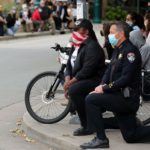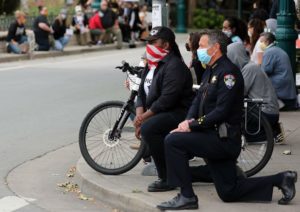We Don’t Need Cops To Take A Knee, We Need Them To Take Off Their Badges…For Good

 Amidst the backdrop of now international uprisings sparked by yet another wave of racist killings by the police, law enforcement agencies nation-wide have armed their envoys with taxpayer-funded, military-grade hardware in hopes of quashing what have become some of the country’s most dissident protests of the millennium.
Amidst the backdrop of now international uprisings sparked by yet another wave of racist killings by the police, law enforcement agencies nation-wide have armed their envoys with taxpayer-funded, military-grade hardware in hopes of quashing what have become some of the country’s most dissident protests of the millennium.
Social media streams are currently overrun with images and videos–very few of which have, without some form of dog whistling, been shown on prime-time media outlets–of mace, tear gas, and rubber bullets being savagely deployed against unarmed citizens.
In certain municipalities, however, police squads have been documented temporarily laying down their weapons and kneeling before the protests they were dispatched to control.
From Minneapolis to Kansas City, Fargo to Ferguson, Portland to Santa Cruz, these police officers have been applauded by many for their supposed compos mentis at a pivotal moment. Photos of police on one knee (some chose instead to raise their fists or clasp hands and bodies with protesters) have made the rounds, ostensibly as a reminder that, to quote one kneeling officer’s handmade sign, “We are one race… The HUMAN race.”
Here’s the problem – biologically speaking, we may very well all be one race (“species” is really a better term), but we aren’t all agents of the capitalist state surveillance apparatus and its monopoly on violence. All police, however, are. For over 400 years this country has been built upon the backs of black, brown, and indigenous bodies, and for at least 300 of them organized militias in the form of police forces both public and private have had the role of disciplining and butchering those bodies. And when, on rare occasions, it was not explicitly racialized, policing was still there to protect the vested interests of a burgeoning merchant class (who literally conned the commonwealth into paying for it – a funding structure we’ve retained to this day) which profited immensely from the national proliferation of racist policy.
There is a raw and dark history to law enforcement in America, and no amount of cops briefly kneeling can erase it. But they can try, and that’s an issue. Because lauding these cursory gestures of amity, as much as they may seem to shed light upon our common humanity or the ways we can spiritually eclipse the larger stakes that divide us, reinforces the “bad apple” myth: the cognitively dissonant notion that the transgressions of police officers are symptomatic of individual, rather than structural, failings. To believe this, then, also means to believe in the myth of the “good apple”: that a percentage (often argued to be the majority) of police are valiant, selfless, and benevolent. All the same, from this viewpoint, the problems of policing become personal. Good cops and their behaviors are examples of the policing system’s natural arc towards justice. Bad cops and their behaviors are the exceptions.
Buying into the “bad/good apple” delusion is what convinces people in the first place that hugging, smiling at, and kneeling with protesters is somehow friendly (or, god forbid, analogous) to real abolitionist work. It’s not. What kneeling and hugging is, is optics. Publicity. Placatory, distracting, politically expedient, and self-preservative in nature – the equivalent of a serial abuser publicly apologizing with a bouquet of flowers. It’s meant to deflect against the fact that each and every officer has willfully taken an oath to act as part and parcel of an organization that pushes for compliance, by threat of force, with the avalanche of inequities that paved and continues to pave the way for white supremacy and exploitative capitalist modes of accumulation. The kneeling is propaganda, plain and simple. It’s what makes the absolutely tone-deaf phrase from Genesee County Sheriff Chris Swanson “I want to make this a parade, not a protest” sound rational at best and good-hearted at worst. And it’s what tries to complicate the fact that, when the kneeling is all said and done, officers will put on their masks to uphold elite interests nonetheless.
How many cops do you see remaining on their knees after curfew, after the media gets their photos and videos, then rising to actively defend protectors against gas attacks, rubber bullet barrages, and weaponized vehicle crashes? How many do you see physically preventing their colleagues from spraying mace into the faces of unarmed demonstrators and their children during a global respiratory pandemic? How many defied their orders and attempted to keep riot-control weapons off the streets to begin with? How many have spoken out against the dramatic increases in state and federal policing budget since Covid-19 paralyzed the economy? How many, in the face of all these obscenities, have decided to go on strike, give up their badge, or actively obstruct the multilayered orders of oppression they once swore to uphold? How many have actually gone beyond the showmanship of denouncing their murderous colleagues and engaged in actions that would obstruct the very system which created them?
The answer: about the same amount that intervened to prevent Derek Chauvin from killing George Floyd.
Defunding, Not Reforming, Is The Way Forward
Politically, trusting in the integrity of individual officers backstops the narrative that reformist methods of controlling police can prevent police murders and brutalities from recurring. Reformist logic has it that, if police departments are put under greater scrutiny to hold their own accountable via specialized training, greater public oversight, body cameras, etc, the result will be safer, more community-oriented forms of law enforcement.
This is simply not true.
For proof, look no further than Minneapolis. In 2015, on the heels of the killing of Jamar Clark, the MPD was one of the first departments to be pressured by a series of reforms outlined under Obama’s Task Force On 21st Century Policing. Included in the president’s legislation were mandatory trainings on implicit bias, de-escalation techniques, and crisis intervention methodologies. The department’s leadership was diversified, body cameras became required, use-of-force standards were tightened, “warrior mentalities” were cracked down upon, mechanisms were implemented for identifying problem officers early on, and community dialogues were put in place. In 2018, the MPD even summed up these adjustments to their procedural justice approach in a self-congratulatory report.
What the report failed to mention was that they have yet to really work.
At base level, as Alex Vitale, author of The End of Policing, notes, these reforms have “nothing to say about the mission or function of policing.” In other words, they identify ways to more justly uphold laws without actually questioning whether the laws themselves are just. The bona fides of institutional policing are granted by simply presuming our laws organically benefit everyone so long as they are enforced in good faith.
Sure enough, blind allegiance to the rule of law has ensured that, as public utilities and services are chronically cut back year after year, policing fills the voids that remain. Poor and non-white communities are denied the most basic social alms – healthcare, schooling, food, jobs – then billboarded as prime examples of why police must exist. This is like generationally starving, harming, and isolating a breed of animal, then arguing that any resulting turbulent behaviors are intrinsic to the breed.
Reformism is a product of this sort of decontextualized thinking, which by its nature cannot address how the fundamental grounds for law enforcement are inexorably tied to the structural inequities and hierarchies of the United States. Amidst a sea of evidence to the contrary, it still accepts police as the de facto solution to the problems facing disenfranchised populations.
Thus, advocates of reform can only imagine fixing the issue of policing by, paradoxically, throwing more money to the police. Make no mistake, reform measures inevitably require more money to be pumped into the already bloated budgets of U.S. police departments ($100 billion is spent annually – an average of $274 million a day). Body cameras and training programs are costly. Community policing techniques are contingent on larger forces and thus bigger hiring budgets. And while not directly tied to department funding, prosecuting and jailing deviant officers via greater oversight and stricter standards is incredibly expensive, and reifies the grotesquely exploitative industrial prison complex (which is funded to the tune of another $80 billion).
Sadly, reformist approaches make up the bulk of the so-called “progressive” justice system agenda of the Democrats. Upon the news of George Floyd, it’s representatives were quick to condemn racist forms of policing, but offered little more. On her Twitter feed, Amy Klobuchar, who has an outstanding record of failing to prosecute killer cops as Hennepin County’s former attorney, seemed more concerned with the damages caused by the rebellions than with the reason for the damages themselves, commending those that were sweeping the streets clean of debris and ultimately calling for little more than yet another DOJ investigation. DNC Chair Tom Perez yet again invoked the names of recent victims of police violence under the vague banner of justice and left it at that. Barack Obama dubiously highlighted the need for and value of police reform, then suggested the best way to achieve it was through peacefully voting for the right persons. All in all, the center-left response has been, predictably, paltry and pandering.
There are, however, alternatives to police reform. And they have precedent. Cities such as Dallas are proving that social workers are more effective first responders to mental health and drug related emergencies. Elsewhere, violence intervention organizations and mutual aid networks have pursued public safety by centering transformative justice ideologies that eschew the presence of police in favor of non-punitive collective action interventions. Nationwide there is real work being done to reclaim the glut of social responsibilities that have, over the past several decades, been pawned off onto police. Given the already dismal clearance rate of crimes that most would agree law enforcement should handle, moving in this direction is a no-brainer.
So the blueprints are there. Only the funding is lacking.
As was made patently clear by the Fed’s recent Covid-19-fueled corporate sweepstakes giveaway, there’s no real shortage of cash. But neither is there the plumbing that would practically get any form of helicopter money where it really needs to go.
More realistically, then, we must slash the gratuitous amount of funds already given to police (New York City alone spends more on police than on health services, housing development, and community outreach combined); funds that, among other things, are used to purchase lists of gear straight out of a Tom Clancy wet dream. We can instead redirect the money to be invested in curbing the real issues threatening public safety such as homelessness, drug abuse, housing, and employment, while ensuring that the other safety issue, the one some mistakenly believe is necessary, loses its edge. Indeed we can and need to if police violence is to end any time soon.